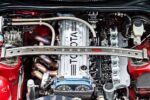When it comes to diesel engines, mechanics often find themselves navigating a maze of myths and misconceptions. One of the most persistent questions that arise is whether you can flood a diesel engine. Unlike gasoline engines, which can easily flood when too much fuel is injected during starting, diesel engines operate on a different principle. Understanding this difference is crucial for anyone working on or owning a diesel vehicle.
Can You Flood a Diesel Engine?
First off, let’s clear the air: flooding a diesel engine isn’t as straightforward as it is with gasoline engines. Diesel engines rely on compression ignition, meaning they compress air to a high temperature and then inject fuel into that hot air, igniting it. This process is fundamentally different from how gasoline engines operate, where fuel is mixed with air before being ignited by a spark. So, can you really flood a diesel engine? The answer is nuanced.
The Mechanics of Diesel Engines
To truly grasp the concept of flooding in diesel engines, it’s essential to understand their mechanics. Diesel engines are designed to handle a specific fuel-to-air ratio, and they thrive on the principle of self-ignition. If too much fuel is injected without sufficient air, you might think you’re flooding the engine, but the reality is a bit different. Instead of drowning in fuel, the engine may simply fail to start or run poorly due to an imbalance in the air-fuel mixture.
Common Scenarios
While it’s challenging to flood a diesel engine in the traditional sense, certain scenarios can lead to similar issues. For instance, prolonged cranking can lead to excessive fuel accumulation in the combustion chamber, which can cause hard starting or even prevent the engine from starting altogether. This situation is often mistaken for flooding, but it’s really just a case of too much fuel and not enough air.
In summary, while you can’t flood a diesel engine like you can with gasoline engines, there are still pitfalls to avoid. Understanding the unique characteristics of diesel engines is vital for any mechanic or owner looking to keep their vehicle running smoothly.
Understanding Diesel Engine Flooding: Myths and Realities
When it comes to diesel engines, the term “flooding” can create confusion. Many people assume that if you pour too much fuel into the engine, it will flood just like a gasoline engine. However, the mechanics of diesel engines are fundamentally different. Let’s dive deeper into this topic and explore what “flooding” really means in the context of diesel engines, the conditions that could lead to similar issues, and how to troubleshoot them.
What Does Flooding Mean?
Flooding typically refers to a situation where an engine has too much fuel in the combustion chamber, preventing it from starting or running properly. In gasoline engines, this is often due to excessive fuel delivery during starting. In diesel engines, however, the scenario is more complex. Here’s why:
| Aspect | Gasoline Engine | Diesel Engine |
|---|---|---|
| Ignition Method | Spark ignition | Compression ignition |
| Fuel Delivery | Air-fuel mixture before ignition | Fuel injected into compressed air |
| Flooding Effect | Hard starting, excessive fuel in the chamber | Hard starting, but not traditional flooding |
Can You Flood a Diesel Engine?
The short answer is no, not in the traditional sense. However, that doesn’t mean diesel engines are immune to starting issues caused by fuel-related problems. Here are some scenarios where you might encounter difficulties:
1. Excessive Cranking
If you crank a diesel engine for too long, especially in cold conditions, you can inject too much fuel into the combustion chamber. This can lead to:
- Fuel pooling in the cylinder
- Increased hydrocarbon emissions
- Difficulty in starting
2. Faulty Fuel Injectors
Leaking or malfunctioning fuel injectors can also cause an over-delivery of fuel. This can lead to:
- Unburned fuel accumulating in the combustion chamber
- Increased engine smoke
- Potential damage to the engine over time
3. Improper Air Intake
If the engine isn’t getting enough air, the fuel-to-air ratio becomes skewed, which can mimic flooding. This can happen due to:
- Clogged air filters
- Blockages in the intake system
- Faulty turbochargers
Troubleshooting Diesel Engine “Flooding”
When you suspect that your diesel engine isn’t starting due to flooding-like symptoms, here’s how to troubleshoot:
| Step | Action | Expected Outcome |
|---|---|---|
| 1 | Check the fuel injectors for leaks | Identify any faulty injectors |
| 2 | Inspect the air intake system | Ensure proper airflow to the engine |
| 3 | Test the fuel system pressure | Verify fuel delivery is within specifications |
| 4 | Crank the engine for a limited time | Prevent excessive fuel accumulation |
By following these steps, you can effectively diagnose and resolve issues that may seem like flooding but are actually related to the unique operation of diesel engines. Understanding these nuances is essential for any mechanic or diesel owner aiming to maintain peak engine performance.




0 Comments